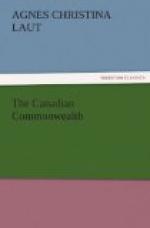III
The question may be asked, do not these large figures presage the hunting to extinction of fur-bearing animals? I do not think so.
Take a map of the northern fur country. Take a good look at it—not just a Pullman car glance. The Canadian government has again and again advertised thousands, hundreds of thousands, millions of square miles of free land. Latitudinally, that is perfectly true. Wheat-wise, it isn’t. When you go one hundred miles north of Saskatchewan River (barring Peace River in sections) you are in a climate that will grow wheat all right—splendid wheat, the hardest and finest in the world. That is, twenty hours of sunlight—not daylight but sunlight—force growth rapidly enough to escape late spring and early fall frosts; but the plain fact of the matter is, wheat land does not exist far north of the Saskatchewan except in sections along Peace River. What does exist? Cataracts countless—Churchill River is one succession of cataracts; vast rivers; lakes unmapped, links and chains of lakes by which you can go from the Saskatchewan to the Arctic without once lifting your canoe; quaking muskegs—areas of amber stagnant water full of what the Indians call mermaid’s hair, lined by ridges of moss and sand overgrown with coarse goose grass and “the reed that grows like a tree,” muskrat reed, a tasseled corn-like tufted growth sixteen feet high—areas of such muskeg mile upon mile. I traversed one such region above Cumberland Lake seventy miles wide by three hundred long where you could not find solid camping ground the size of your foot. What did we do? That is where the uses of a really expert guide came in; we moored our canoe among the willows, cut willows enough to keep feet from sinking, spread oilcloth and rugs over this, erected the tents over all, tying the guy ropes to the canoe thwarts and willows, as the ground would not hold the tent pegs.
It doesn’t sound as if such regions would ever be overrun by settlement—does it? Now look at your map, seventy miles north of Saskatchewan! From the northwest corner up by Klondike to the southeast corner down in Labrador is a distance of more than three thousand miles. From the south to north is a distance of almost two thousand miles. I once asked a guide with a truly city air—it might almost have been a Harvard air—if these distances were “as the crow flies.” He gave me a look that I would not like to have a guide give me too often—he might maroon a fool on one of those swamp areas.
“There ain’t no distances as the crow flies in this country,” he answered. “You got to travel ’cording as the waters collect or the ice goes out.”




